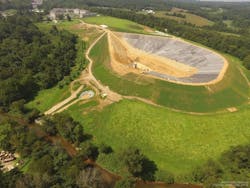Mt Soma Reservoir
Cost: $6,254,677
Location: Bel Air, Md.
Year: 2019-12-01
Size: 90 million gal
Owner: Maryland American Water
Designers: Gannett Fleming, Inc.
Contractor: Allan Myers
Maryland American Water (MAW) supplies Bel Air-area customers with water sourced from Winters Run. During times of drought, the utility supplemented this supply with water provided by Harford County, but the supply was not guaranteed. In 2014, a temporary purchase arrangement between MAW and the county was approved with the understanding that a long-term back source, independent of the county’s supply, would be secured within four years. The Mt. Soma Reservoir satisfies this requirement, using a 62 ft high earthen embankment with a 20 ft wide crest to store up to 90 million gal of raw water. The water can be conveyed to an adjacent treatment plant as needed for use during drought and emergencies.
The project included a 0.25-mile-long road allowing residents to access the Soma historic site adjacent to the impoundment. The team built the facility without disturbing the 300 year old Mt. Soma barn near the site.
The facility uses sustainable water quality improvement systems to maintain water quality and impede algae growth in the impoundment. At Mt. Soma, seven man-made, floating wetland units hold 4,000 native aquatic plants and cover 3,000 sq ft. of the reservoir’s surface. Microbes in the biofilm surrounding the plants’ root systems break down and absorb algae-promoting nutrients, reducing nitrogen and phosphorus content by approximately 30%. A solar-powered, ultrasonic algae control system removes up to 90% of existing algae in the water and inhibits new growth. A solar-powered water mixer promotes oxygenation and prevents stagnation, maintaining water quality. Both systems use renewable power, reducing environmental impacts.
The impoundment was positioned so gravity could be used to send water to the treatment plant over a 500 ft run, which avoids the use of pumps and saves energy.
Soil at the project site was rich in mica, so engineers completed 50 more laboratory water content tests than were specified in the contract and developed a family of compaction curves applicable to on-site soil, which avoided hauling out or disposing of tens of thousands of cubic yards of material.
“Our work took place during one of the wettest years on record. An earthen dam has very rigorous soil and compaction requirements,” said Likovich. “When you have rain on the exposed soil, prior to completely placing the liner, the soil must be reworked to make sure it meets the specifications of the design.”
A bituminous geomembrane liner (BGM) was used to create a watertight barrier to prevent seepage inside the 2,025 ft long dam embankment and impoundment bottom. BGM liners are more common in Europe than in the U.S., where they are often used in the mining industry. The impoundment marks the second time in history a BGM liner has been used to line a water supply reservoir in the U.S. and the first time on the East Coast.
Project Year: 2019-12-01Contractor: Allan Myers Designers: Gannett Fleming, Inc. Owner: Maryland American Water Location: Bel Air, Md. Cost: $6,254,677 Size: 90 million gal